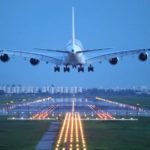The post Global Air Travel Demand Continued Its Bounce Back in 2023 appeared first on TD (Travel Daily Media) Brand TD.

The International Air Transport Association (IATA) reported that the recovery in air travel continued in December 2023, with total 2023 traffic coming closer to meeting pre-pandemic demand.
Total traffic in 2023 (measured in revenue passenger kilometres, or RPKs) increased 36.9% over 2022. Globally, traffic in 2023 was 94.1% of pre-pandemic levels (2019). December 2023 overall traffic increased by 25.3% over December 2022, reaching 97.5% of the December 2019 figure. Traffic in the fourth quarter of 2019 was 98.2%, indicating a significant comeback towards the end of the year.
International traffic 2023 increased 41.6% over 2022, reaching 88.6% of 2019 levels. In December 2023, international traffic increased 24.2% over December 2022, reaching 94.7% of the level in December 2019. Traffic increased by 94.5% in the fourth quarter of 2019.
Domestic traffic in 2023 increased by 30.4% compared to the previous year. Domestic traffic in 2023 was 3.9% higher than in the whole year of 2019. Domestic traffic in December 2023 increased by 27.0% over the previous year, 2.3% higher than in December 2019. Fourth-quarter traffic rose 4.4% compared to the same quarter in 2019.
“The strong post-pandemic rebound continued in 2023. December traffic stood just 2.5% below 2019 levels, with a strong performance in quarter 4, teeing airlines for a return to normal growth patterns in 2024. The recovery in travel is good news. The restoration of connectivity is powering the global economy as people travel to do business. Further, their educations, hard-earned vacations and much more. However, governments need to take a strategic approach to maximize the benefits of air travel in the post-pandemic world. That means providing cost-efficient infrastructure to meet demand, incentivizing Sustainable Aviation Fuel (SAF) production to meet our net zero carbon emission goal by 2050, and adopting regulations that deliver a clear cost-benefit. Completing the recovery must not be an excuse for governments to forget the critical role of aviation in increasing the prosperity and well-being of people and businesses the world over,” said Willie Walsh, IATA’s Director General.
International Passenger Markets
Asia-Pacific Airlines reported a 126.1% increase in full-year international traffic in 2023 compared to 2022, retaining the region’s highest year-over-year pace. Capacity increased by 101.8%, while the load factor increased by 9.0 percentage points to 83.1%. In December 2023, traffic increased by 56.9% compared to December 2022.
European airlines’ full-year traffic increased 22.0% compared to 2022. Capacity climbed by 17.5%, while load factor rose by 3.1 percentage points to 83.8%. Demand rose 13.6% in December compared to the same month in 2022. For the first time since the pandemic began, traffic in December exceeded that of the same month in 2019.
Middle Eastern airlines’ traffic increased 33.3% in 2023 compared to 2022. Capacity grew by 26.0%, while load factor jumped 4.4 percentage points to 80.1%. December demand rose 16.6% over the same month in 2022.
North American carriers reported a 28.3% yearly traffic increase in 2023 over 2022. Capacity grew by 22.4%, while load factor rose 3.9 percentage points to 84.6%. In December 2023, traffic increased by 13.5% compared to the previous year.
Latin American airlines increased their traffic by 28.6% in 2023 compared to the previous year. Annual capacity increased by 25.4%, while the load factor rose 2.1 percentage points to 84.7%, the region’s highest. December demand increased by 26.5% compared to December 2022.
African airlines’ yearly traffic increased 38.7% in 2023 compared to the previous year. Full-year capacity in 2023 increased by 38.3%, while the load factor increased by 0.2 percentage points to 71.9%, the lowest among regions. In December 2023, African airline traffic increased by 9.5% over December 2022.
China’s full-year domestic traffic increased by 138.8% compared to 2022 and is already 7.1% higher than in 2019.
Australia (-4.2% vs 2019) and Japan (-3.2% versus 2019) are the only major domestic markets that have yet to restore pre-pandemic traffic demand.
“Our push to connect our world even more strongly than before the pandemic must not come at the expense of our environment. The industry’s goal to reach net zero CO2 emissions by 2050 remains steadfast. We need governments and fuel suppliers to step up and do more to accelerate the transition. We saw a strong increase in the use of SAF in 2023, but SAF is still only 3% of all global renewable fuel production. That is unacceptable. Aircraft have no option but to rely on liquid fuels, whereas other transport modes have alternatives. A massive collective effort is needed to increase SAF output as a proportion of overall renewable fuel production as quickly as possible,” said Walsh.
The post Global Air Travel Demand Continued Its Bounce Back in 2023 first appeared on Stray Nomad Travel News.
The post Global Air Travel Demand Continued Its Bounce Back in 2023 appeared first on Brand TD.

